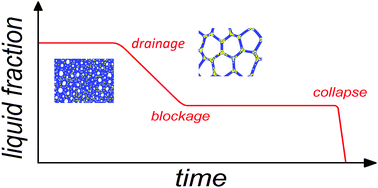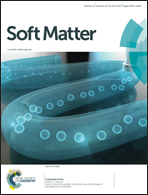Foamed emulsion drainage: flow and trapping of drops†
Abstract
Foamed emulsions are ubiquitous in our daily life but the ageing of such systems is still poorly understood. In this study we investigate foam drainage and measure the evolution of the gas, liquid and oil volume fractions inside the foam. We evidence three regimes of ageing. During an initial period of fast drainage, both bubbles and drops are very mobile. As the foam stabilises drainage proceeds leading to a gradual decrease of the liquid fraction and slowing down of drainage. Clusters of oil drops are less sheared, their dynamic viscosity increases and drainage slows down even further, until the drops become blocked. At this point the oil fraction starts to increase in the continuous phase. The foam ageing leads to an increase of the capillary pressure until the oil acts as an antifoaming agent and the foam collapses.



 Please wait while we load your content...
Please wait while we load your content...